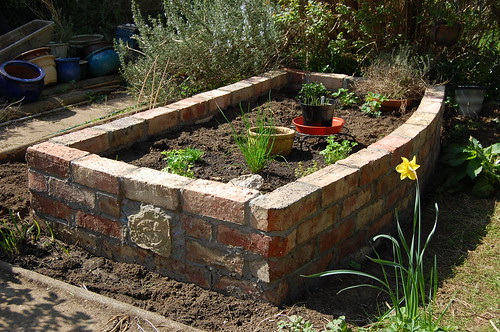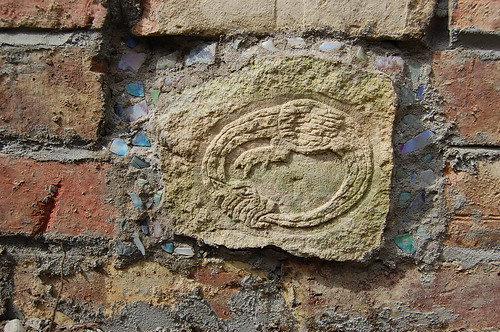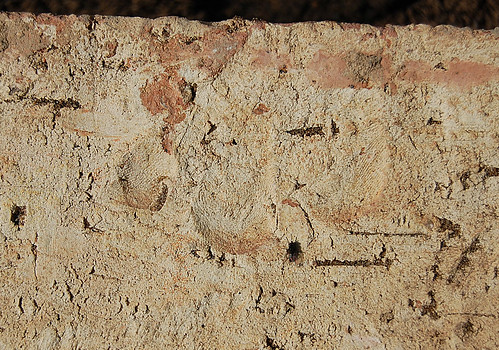
I've finally got round to doing something I've meant to do ever since I moved here in 2004 - install a proper herb garden. In my previous garden, which was a miniscule 30ft by 12ft, I didn't have room to grow many vegetables and so herbs were my main thing. In that tiny garden I collected 80 varieties of herbs - culinary, medicinal and shamanic ones. But over the years most have been lost, either by dying off or having to be left behind when I moved. I always intended to make a new one, but it's taken me six years.
Last year a friend up the road had some alterations done in her house which involved knocking two rooms into one, and she said I could have the bricks if I wanted to come round and collect them. As it was an 1890s house and the bricks were lovely handmade ones full of character, I thought they would be perfect for building a raised herb bed. They didn't feel quite so perfect after I'd lumped 140 of them into the boot of my small and very antique VW Polo and made three journeys back home with the exhaust pipe practically scraping along the road - and I was so knackered I stacked them up round the side of the house and didn't do anything with them for a year.
Beautiful as Victorian bricks are, if you've ever salvaged "pre-owned" bricks you'll know what a fun job it is to chisel all the old mortar off them, which has to be done before you can re-use them. But once I'd got enough of them cleaned up, I made this rather nice walled bed. It's five courses high, curved along the front edge, and has enough room for a good collection of plants which will have full sun and good drainage. There's also a border at the back of it which faces south-west, and with the shelter and the reflected light/heat from the bricks it should make another good place to grow some of the more marginal herbs.

The new herb bed planted up with a few things already. Chives, chamomile, oregano and various thymes and parsleys.
Yes, it's a bit amateur and homespun. I've never done bricklaying before (and I don't have a bloke to do this kind of stuff for me) so I just get on with it and hope for the best. I probably shouldn't admit this but I didn't make any measurements or design plans at all. I just laid out the bricks on the ground until I liked the look of them and cut round them to make the outline for the foundations. Then I positioned them all by eye without recourse to tape measure, string-line, set-square or spirit level. What would Geoff Hamilton say? Maybe I'm daft but I'm just not the kind of girl who measures or plans things. Everything I do is improvised. To be honest, the bricks are all so individual and full of subtle variations it would still have looked a bit wonky even if I had meticulously planned everything. So bugger it. I like wonky things anyway.
And as I was building it I suddenly hit on this idea of incorporating this carved stone ouroboros which I've had lying around for years. It dates back to when I was 19 and lived in a farm cottage on a Cotswold hillside (which was freezing cold and infested with mice, before anyone has the word 'idyllic' get anywhere near their head). In my youthful idealism I used to go up the hill and find flat-faced chunks of Cotswold stone, then half kill myself lugging them back to the cottage to carve medieval motifs on them. The hill where I lived, Bredon Hill in Worcestershire, was circled by pretty villages with ancient churches, some of which had spectacular medieval stone carvings in them. The idea was to make hand-made copies of some of these carvings. I can't remember which parish I found the ouroboros design in, but anyway, I spent a happy few days smacking seven kinds of hell out of a chunk of stone until this little chap emerged.

Ouroboros carving, set with a few bits of coloured glass.
I love the ouroboros symbol. It's a deep alchemical motif which carries the idea of motion within stillness, completion, wholeness, energised balance and eternal renewal of cycles. All good things to have in a garden. For years I've been carrying my ouroboros (and a couple of others I made at the time) around with me and could never decide what to do with it. After all this time it's beautifully and naturally weathered - and it fits into the wall perfectly.
Another slightly more subtle feature in the wall … when I was lumping bricks into the car I spotted a set of fingerprints in one of the bricks. It had been pressed into the clay before it was fired, and thus preserved. Maybe this picture isn't the clearest, but the brick retains every detail of the lines in this person's fingers. Things like this are really precious to me. I love the idea that an unknown brickyard worker imprinted their identity into a housebrick 120 years ago and it still survives today as clearly as if it had been made yesterday. Perhaps it has an added significance to me because my grandfather was a brickmaker. Not that there's anything remotely romantic about that. In fact it killed him at age 37. But these little personal touches (literally) of people long gone from the world are the most special historical treasures to me.

A brickmaker's fingerprints etched into a brick surface.
That's not the only bit of hard landscaping I've done this week. My neighbour informed me the other day that he is giving up growing vegetables, because "they don't come to anything anyway, it's a waste of time" (speak for yourself, mate) and turfing over his vegetable patch. I find that very sad, but each to their own. I have benefited from it personally though, because he offered me the edging stones which had formerly made the boundaries of his vegetable garden, which happened to be exactly the right size and quantity for edging the path in my greenhouse, for which I had been trying to psych myself up for a trip to Wickes because I was in urgent need of some. These are old tiles and far nicer than anything I could have got from Wickes anyway. Thank you God. Thank you neighbour.*
*Not that the two are in any way synonymous.
12 comments:
wonderful raised bed with bricks. I love it. Actually that made me reconsidering the final material for my coming up this mont new vegetable beds. I planned to make them using wood, but it will last maximum 5 years - bricks are more solid.
.
or am I looking for excuses to not do it?
.
Greetings,
Love the raised bed! I think you did a very good job. But I know nothing about laying bricks.
Nice touch with the old fingerprint. Your own little bit of history.
My allotment site once had a lot of brick summerhouses on it. Almost all were knocked down by the Council in the 1970's, leaving only a couple of survivors. Many of the bricks ended up in the stream, and I've been salvaging them over the years to build a path. I'm currently halfway down the plot, and I've got enough bricks to finish it. The one thing to watch out for is that some of them weren't fired hot enough to be water proof (I think it was the temperature anyway), and if they get damp they come to pieces when there's a frost.
Well done on a very individual raised bed. I'd be lost without my herb garden, small though it is. It's right outside the back door because I'm such a lazy beggar I'd find excuses not to use the herbs if I had to traipse down the garden in the rain for them!
I love your carving. There are some fantastic symbols in old churches - often pagan or even rather rude. Jack in the green and the sheila-na-gig for example.
Thank you all.
Ewa, it was a lot of work - it took me a whole day to do each layer of bricks. But it is a long term investment!
I did have some concerns, Robert, about the durability of the bricks, which is another reason I left them outside all winter. They came from an interior wall and I wasn't sure how weatherproof they would be. But I've tried to put the most solid surfaced ones on the top, and I don't mind if they flake a little bit ... just hoping they don't disintegrate.
Kath, I'm the same, so this bed is right next to the patio because I improvise all my cooking as well as everything else, and I tend to rush out and pick herbs on a whim while I've got a pan on the stove. I've had a long term fascination with carvings in churches, especially the pagan ones. I photograph green men wherever I find them - shiela-na-gigs are less common but it's all the more of a treat to find one.
It's funny sometimes how these things work.
I've both been working on my own patch of herbs for growing on my roof. It doesn't really work to grow these at the allotment, because I have to plan ahead to use fresh herbs and remember to bring them home. I've just been cleaning up a large planter for this.
Also, as part of my foundation repair that's been dragging on, I have an original wall in my house I've been thinking about removing. It's also of handmade bricks. I just can't bring myself to remove such an old part of my house, no matter how much I'd like to have a larger room. My contractor told me, if I cleaned the bricks first, I could probably sell them for about 2 euros a piece.
Hi Rebsie,
Nothing wrong with a bit of arts & crafts brickwork. It's you that has to look at it after all.
I have new plot at last, after nearly 3 years, and "Dig for Victory" lives again!
www.digforvictory.blogspot.com
Beautiful brickwork! I just have mine stacked so the water can filter...the problem is that they keep getting knocked over by the squirels!
The raised herb bed is wonderful and makes my five pots on the kitchen windowsill somewhat pathetic. It has certainly inspired me to be a little more ambitious.
Mary Bailey
Wickford, Essex, U.K.
English Garden
Love herbs and love bricks. I've collected about 100 from skips recently (even asking permission). Bemused homeowners usually think I'm asking to put things in the skip not take them out. If you use a double thickness you can make a low raised bed without using mortar as Mojo at http://vrtlarica.blogspot.com/ has shown. I planned to copy this but I keep on finding other uses for them, notably weighing down fleece and thrip netting against the ferocious Hibernian wind and carrot midgies. I need another neigbour to go open plan before I can realise my dream. Another problem you have anticipated is the quality of the bricks is poor. Notably the local "Hailes" brickworks shut down because the quality of brick was not particularly good. I can vouch for this as several of the ones in the open at my plot have gone pfff over the winter. I feel sure that once interlocked the problem would be significantly reduced.
(Also would mention that I'm not repeating the Shetland Black experience this year as the yield was so low, the size was small, they seemed to be prone to disease and the pests went to town on them. They did make a lovely sludgey grey mound on the plate. But joking apart I do love diversity and keeping a tradition alive (and I still love your write up on them).
Mal, a new follower.
I love this! So glad I stumbled onto your blog. I live in Baja Mexico. Just 40 minutes under California US. I have tried to grow herbs. I have some still, but never thought about grouping them together in a little bed. I think I will try this.Thanks!
How is your herb garden?
Post a Comment